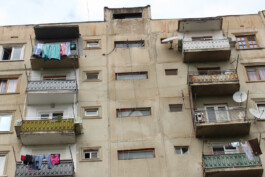BUILT SOCIETY IN THE
(POST)-SOVIET MICRO-RAYONS
Tinatin Gurgendize
The Adaptation of the Mass Housing Blocks by its Inhabitants at the Example of Gldani in Tbilisi in the late Soviet Period of the 1970´s and 1980´s. The main question of this work explores the influences and interrelations between the built space and living environs residing in (Post) Soviet Micro Districts (Micro Rayons). The work concentrates on the periphery settlements that were built during 1970´s and 1980´s in former Soviet Union. Questioning the cultural and geographical contexts and the expression of the society reflected on architecture during the developments that took place after the break up of the Soviet Union. This work reflects on the adaptation and appropriation strategies of inhabitants of public and their private spaces and understands how these processes express the phenomenon of a (Post)-Soviet built society in Georgia. The major district to investigate is Gldani which is (was) a mass-dormitory suburb situated in the periphery of Tbilisi, Georgia. Gldani consists of nine ‘micro-rayons’ designed in the 1970s and provides a home for approximately 170,000 inhabitants. The thesis discusses the processes of change affecting these Soviet living environs. To what extend the everyday life of the inhabitants is standardized and their lifestyle controlled by being embedded in these homogenous spaces and what happens after the district that was built according to soviet norms and standards finds itself in the new reality in a radically different system and country.

BUILT SOCIETY IN THE
(POST)-SOVIET MICRO-RAYONS
The Adaptation of the Mass Housing Blocks by its Inhabitants at the Example of Gldani in Tbilisi in the late Soviet Period of the 1970´s and 1980´s. The main question of this work explores the influences and interrelations between the built space and living environs residing in (Post) Soviet Micro Districts (Micro Rayons). The work concentrates on the periphery settlements that were built during 1970´s and 1980´s in former Soviet Union. Questioning the cultural and geographical contexts and the expression of the society reflected on architecture during the developments that took place after the break up of the Soviet Union. This work reflects on the adaptation and appropriation strategies of inhabitants of public and their private spaces and understands how these processes express the phenomenon of a (Post)-Soviet built society in Georgia. The major district to investigate is Gldani which is (was) a mass-dormitory suburb situated in the periphery of Tbilisi, Georgia. Gldani consists of nine ‘micro-rayons’ designed in the 1970s and provides a home for approximately 170,000 inhabitants. The thesis discusses the processes of change affecting these Soviet living environs. To what extend the everyday life of the inhabitants is standardized and their lifestyle controlled by being embedded in these homogenous spaces and what happens after the district that was built according to soviet norms and standards finds itself in the new reality in a radically different system and country.
